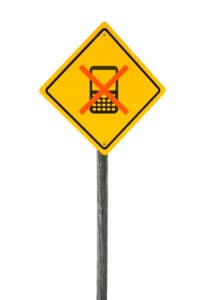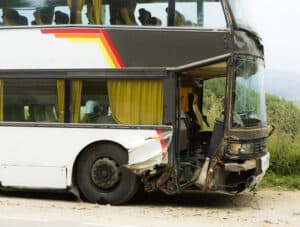7 Safety Risks for Bus Transportation
March 7, 2023
How Common Safety Risks Cause Bus Accidents & How to Avoid Them
Buses can offer a safe way to get around. They can also present some distinct risks and dangers on the road, especially when certain parties fail to be as careful or responsible as they should be. In fact, the latest data shows that at least 104 commercial vehicle accidents happen every day in Texas, and many of these wrecks involve buses.
When buses are involved in traffic collisions in the Lone Star State, here are the dangerous conditions that are often involved.
1. Distracted Driving
Motorists who are not paying attention to the road can be just as risky as drunk or impaired drivers, experiencing misperceptions and delayed responses.

- Texting or using cellphones
- Eating or drinking
- Getting directions or using navigation systems
- Talking to passengers and not paying attention to the road
If you’re riding a bus and feel like the bus driver is distracted, you have a right to:
- Ask the bus driver to stop.
- Suggest that the bus driver pull over if they need help with directions or if there’s an issue with the bus.
- Report the risky driving to the bus company.
2. Speeding
Every day in Texas, speeding is involved in at least 81 traffic accidents, recent statistics show. While any motorist can speed behind the wheel, bus drivers may make the mistake of exceeding the speed limits when they are:
- Distracted: Failing to pay attention to the roads can mean overlooking speed limit signs and driving at unsafe speeds.
- Impaired: Drunk or drugged drivers can have lead feet, stepping hard on the gas and ignoring speed limit signs too.
- Running behind schedule: If bus drivers are late for any reason, they may be tempted to speed to get back on track.
- Experiencing road rage: Blinding anger can give rise to speeding behind the wheels of buses (and passenger vehicles), increasing the risks of bus crashes.
Remember, no matter what’s happening on the roads, bus drivers should never speed. Additionally, bus drivers should generally take it a bit slower, reducing speeds to safely operate buses, whenever the following is present:
- Bad weather, like heavy rains, dense fog, or violent storms
- Sharp turns and/or steep grades on roads
- Road construction or highway work zones
- Poorly maintained roads
3. Impairment

- Recklessly operating the bus: Speeding, failing to check blind spots, and zigzagging in and out of traffic are a few ways that drivers may carelessly operate buses if they’re impaired.
- Failing to comply with traffic laws: Drunk or drugged bus drivers are more likely to run red lights, fail to yield the right-of-way, and otherwise violate traffic laws on the roads.
- Causing crashes: Impaired bus drivers usually experience slower reaction times while overlooking and/or mistaking cues in their environment. That can create confusion and lead to the wrong responses, especially in critical situations when drivers have seconds to make accident-avoiding maneuvers.
4. Bus Driver Fatigue
Like distraction and impairment, fatigue is another roadway danger that can negatively affect drivers’ abilities to safely operate buses. In fact, with bus driver fatigue:
- Overworking or overscheduling drivers can be an issue: This can involve risky decisions made by managers or the dangerous policies in place at bus companies.
- Health conditions can be involved: Sleep apnea and other health issues can result in chronic fatigue. Proper treatment can address this condition and minimize behind-the-wheel fatigue.
Signs of bus driver fatigue can include (and are not limited to):
- Irritability
- Droopy eyelids
- Yawning
- Head bobbing
- Forgetfulness
- Taking the wrong route
- Not complying with speed limits or other traffic laws
5. Insufficient Bus Driver Training
Bus drivers must complete certain training to obtain a commercial driver’s license and the qualifications necessary to safely operate buses. Additionally, there can be specific training requirements for different types of buses, like school buses versus minibuses versus double-decker buses, and some bus drivers may need to do ongoing training to maintain their licensing.
Without sufficient training, drivers may not understand how to identify certain risks, operate buses in tricker conditions, or safely inspect bus equipment. That can increase the chances of bus accidents, usually putting bus companies and/or others in the hot seat when poorly trained drivers cause wrecks.
6. Worn Tires
As vital equipment for any vehicle, tires tend to sustain a lot of wear and tear on buses, particularly those that traverse poorly maintained roads. That can result in tires that are balding, severely worn, and don’t provide sufficient traction. It can also raise the risks of blowouts when buses make contact with potholes, glass, or other debris on the roads.
Generally, inspecting, maintaining, and replacing bus tires are the responsibilities of bus drivers and/or bus companies. These parties are also obligated to outfit buses with the proper tires and other safety equipment.
If worn tires are left on buses and those tires contribute to wrecks:
- Bus drivers and/or bus companies may be at fault.
- Bus inspection and maintenance records can be key evidence to establishing tire problems and negligence.
7. Other Bus Maintenance Failures
Beyond tires, other equipment on buses also requires routine inspection and maintenance. This can include everything from the brakes and the ignition system to the lighting, the electrical system, the emergency exits, and more. Failing to conduct these inspections can mean risky, broken, or defective equipment remains in place, threatening to cause critical failures and bus accidents.
Keep in mind that it’s not always obvious or easy to ascertain when maintenance failures are factors in bus crashes. That’s why it’s crucial to conduct thorough investigations of bus accidents, including in-depth records reviews.
With the help of an experienced bus accident attorney, victims can trust that no stone will go unturned in a crash investigation — and that they’ll have stronger chances of recovering the compensation they may deserve.
How to Determine the Causes of a Bus Accident

- Carefully look at the bus accident photos and/or any available videos (of the wreck or the aftermath) to see how the crash occurred and whether driver actions or inactions may have been involved.
- Get a copy of the police report for the accident, examining it for possible evidence of fault.
- Dig into the records available for the bus, the bus driver, and/or the bus company.
- Don’t put yourself in the hot seat by accidentally admitting fault, apologizing, or accepting any blame.
- Contact a bus accident lawyer, share more about what happened to you, and get confidential advice about your options for proceeding.
